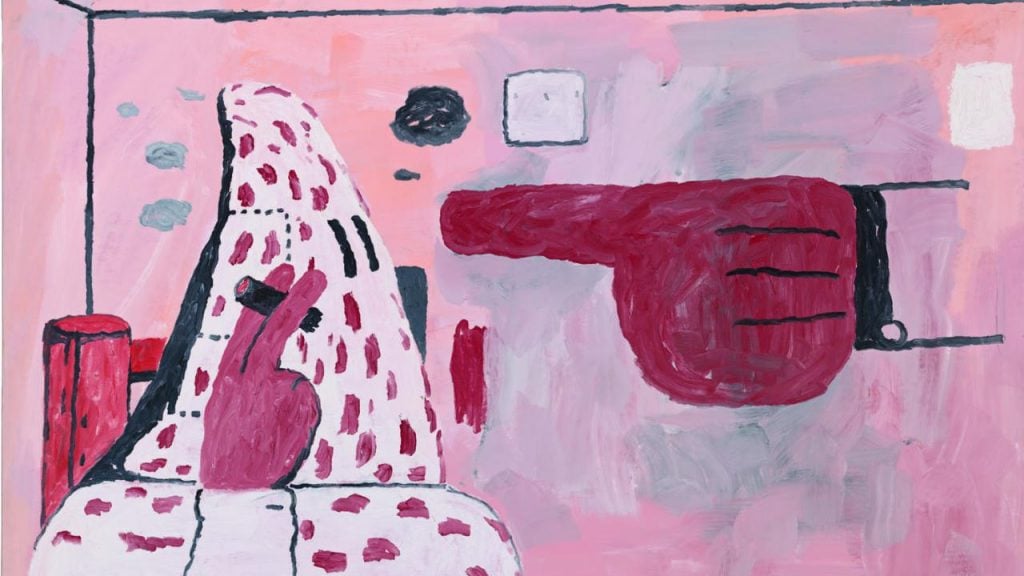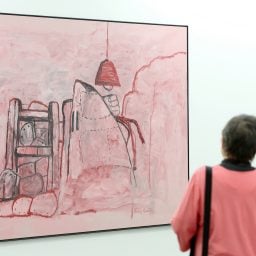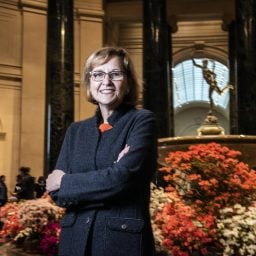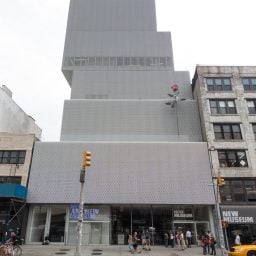Nearly 100 artists, writers, and scholars, including Adrian Piper, Martin Puryear, Matthew Barney, Coco Fusco, Benjamin Buchloh, and Zoe Leonard, have signed an open later admonishing four art museums for postponing a major retrospective of Philip Guston until 2024.
The National Gallery of Art in Washington, DC; the Museum of Fine Arts, Houston; the Tate Modern in London, and the Museum of Fine Arts, Boston announced their joint plan to move the show, “Philip Guston Now,” citing the artist’s depiction of hooded Ku Klux Klan figures.
“Because they are an important part of Guston’s oeuvre, we sought to find a way to include them while being mindful of the context that would be required for viewers to better understand why Guston made them,” the institutions said in a joint email to Artnet News at the time. “As issues of race and social justice have become increasingly part of public dialogue over the last several months, it became apparent we needed to rethink our interpretation of these works.”
The news was quickly met with uproar, including from Guston’s daughter, Musa Mayer, art historians Darby English and Robert Storr, and one of the Tate’s own curators. Now, an A-list cadre of contemporary artists and intellectuals have similarly decried the museums’ decision in an open letter that asks them to reinstate the exhibition as planned.
“Rarely has there been a better illustration of ‘white’ culpability than in these powerful men and women’s apparent feeling of powerlessness to explain to their public the true power of an artist’s work—its capacity to prompt its viewers, and the artist too, to troubling reflection and self-examination,” the letter reads.
“But the people who run our great institutions do not want trouble,” it continues. “They fear controversy. They lack faith in the intelligence of their audience. And they realize that to remind museum-goers of white supremacy today is not only to speak to them about the past, or events somewhere else. It is also to raise uncomfortable questions about museums themselves—about their class and racial foundations.”

Philip Guston, Scared Stiff (1970). The estate of Philip Guston, courtesy of the estate and Hauser & Wirth.
The letter was first drafted by art critic and author Barry Schwabsky, who sat down to write it shortly after the museums’ announcement.
“When I saw the news about the Guston show, I just got so agitated and, frankly, anguished, that I just had to do something,” Schwabsky told Artnet News in an email. “This may sound absurd, but I felt something like what I’d just felt with the death of Ruth Bader Ginsburg and the Republicans’ unseemly haste to replace her. So I wrote this very emotional, very personal letter that I sent around to a group of about eight friends, asking them what they thought about it.”
Thereafter came a number of additional drafts as more and more people signed on. Adrian Piper, Schwabsky says, was particularly “crucial” to the editing process. He approached the Brooklyn Rail, which first shared the letter in an email, over the weekend.
None of the four museums immediately responded to requests for comment.
Read the full text of the letter below, and add your own signature here.
We were shocked and disappointed to read the news that the National Gallery of Art, Washington, D.C.; Museum of Fine Arts, Boston; the Museum of Fine Arts, Houston; and Tate Modern, London, had postponed by four years their planned exhibition Philip Guston Now, which had already been delayed until 2021 by the COVID-19 lockdown. The reason for the postponement? The explanation given by the directors of the four institutions in their announcement expresses anxiety about the response that might be unleashed by certain paintings in which Guston depicts Ku Klux Klansmen, and their preference to “reframe [their] programming and … step back and bring in additional perspectives and voices to shape how [they] present Guston’s work to [their] public.” These institutions thus publicly acknowledge their longstanding failure to have educated, integrated, and prepared themselves to meet the challenge of the renewed pressure for racial justice that has developed over the past five years. And they abdicate responsibility for doing so immediately—yet again. Better, they reason, to “postpon[e] the exhibition until a time” when the significance of Guston’s work will be clearer to its public.
The best riposte to the museum directors’ failure of nerve is conveyed by quoting Guston’s daughter, Musa Mayer, as reported in the New York Times: “My father dared to unveil white culpability, our shared role in allowing the racist terror that he had witnessed since boyhood, when the Klan marched openly by the thousands in the streets of Los Angeles. As poor Jewish immigrants, his family fled extermination in the Ukraine. He understood what hatred was. It was the subject of his earliest works. […] This should be a time of reckoning, of dialogue. These paintings meet the moment we are in today. The danger is not in looking at Philip Guston’s work, but in looking away.”
Rarely has there been a better illustration of “white” culpability than in these powerful men and women’s apparent feeling of powerlessness to explain to their public the true power of an artist’s work—its capacity to prompt its viewers, and the artist too, to troubling reflection and self-examination. But the people who run our great institutions do not want trouble. They fear controversy. They lack faith in the intelligence of their audience. And they realize that to remind museum-goers of white supremacy today is not only to speak to them about the past, or events somewhere else. It is also to raise uncomfortable questions about museums themselves—about their class and racial foundations. For this reason, perhaps, those who run the museums feel the ground giving way beneath their feet. If they feel that in four years, “all this will blow over,” they are mistaken. The tremors shaking us all will never end until justice and equity are installed. Hiding away images of the KKK will not serve that end. Quite the opposite. And Guston’s paintings insist that justice has never yet been achieved.
In the face of an action such as that taken by these four august institutions, we ask ourselves, as private individuals, what we can do. We can speak out, certainly. But we must do more. We demand that Philip Guston Now be restored to the museums’ schedules, and that their staffs prepare themselves to engage with a public that might well be curious about why a painter—ever self-critical and a standard-bearer for freedom—was compelled to use such imagery. That does not permit the museums to fall back on the old discredited stance: “We are the experts. Our job is to show you what’s of value in art and your part is to appreciate it.” It means that museums must engage in a reckoning with history, including their own histories of prejudice. Precisely in order to help take that effort of reckoning forward, the Philip Guston Now exhibition must proceed as planned, and the museums must do the necessary work to present this art in all its depth and complexity.
Marina Adams
William Agee
Richard Aldrich
Svetlana Alpers
Ellen Altfest
Joan Banach
Matthew Barney
Julian Bell
Larry Bell
Lisa Blas
Ross Bleckner
Yve-Alain Bois
Benjamin Buchloh
Gillian Carnegie
David Carrier
Mel Chin
Rob Colvin
Thierry de Duve
Catherine de Zegher
Peter Doig
Phoebe d’Huerle
Nicole Eisenman
Darby English
Hadi Fallahpisheh
Rafael Ferrer
Coco Fusco
Charles Gaines
Peter Galassi
Ellen Gallagher
Mark Thomas Gibson
Barbara Gladstone
Amanda Gluibizzi
Tim Griffin
Nicolas Guagnini
Wade Guyton
Rachel Haidu
Kathy Halbreich
Rachel Harrison
Maria Hassabi
Jennifer Higgie
A.C. Hudgins
Joan Jonas
Eungie Joo
Michael Joo
Isaac Julien
Sanya Kantarovsky
Caitlin Keogh
Alex Kitnick
Christian Kleinbub
Jill Kraus
Leigh Ledare
Ralph Lemon
Zoe Leonard
Ken Lum
Joseph Masheck
Julie Mehretu
Fred Moten
Didier Ottinger
Adrian Piper
Joachim Pissarro
William Pope.L
Eva Presenhuber
Martin Puryear
R.H. Quaytman
Marc Quinn
Archie Rand
Gabriela Rangel
Will Rawls
Ann M. Reynolds
Sara Roffino
Emmanuel Roman
Barbara Rose
Raphael Rubinstein
Sherman Sam
Dana Schutz
Barry Schwabsky
Allan Schwartzman
Amy Sillman
Lorna Simpson
Avery Singer
Kate Sutton
Carol Szymanski
Henry Taylor
Mickalene Thomas
Rirkrit Tiravanija
Jeremy Toussaint-Baptiste
Vincent Valdez
David Velasco
William Villalongo
Hamza Walker
Stanley Whitney
Christopher Williams
John Yau










